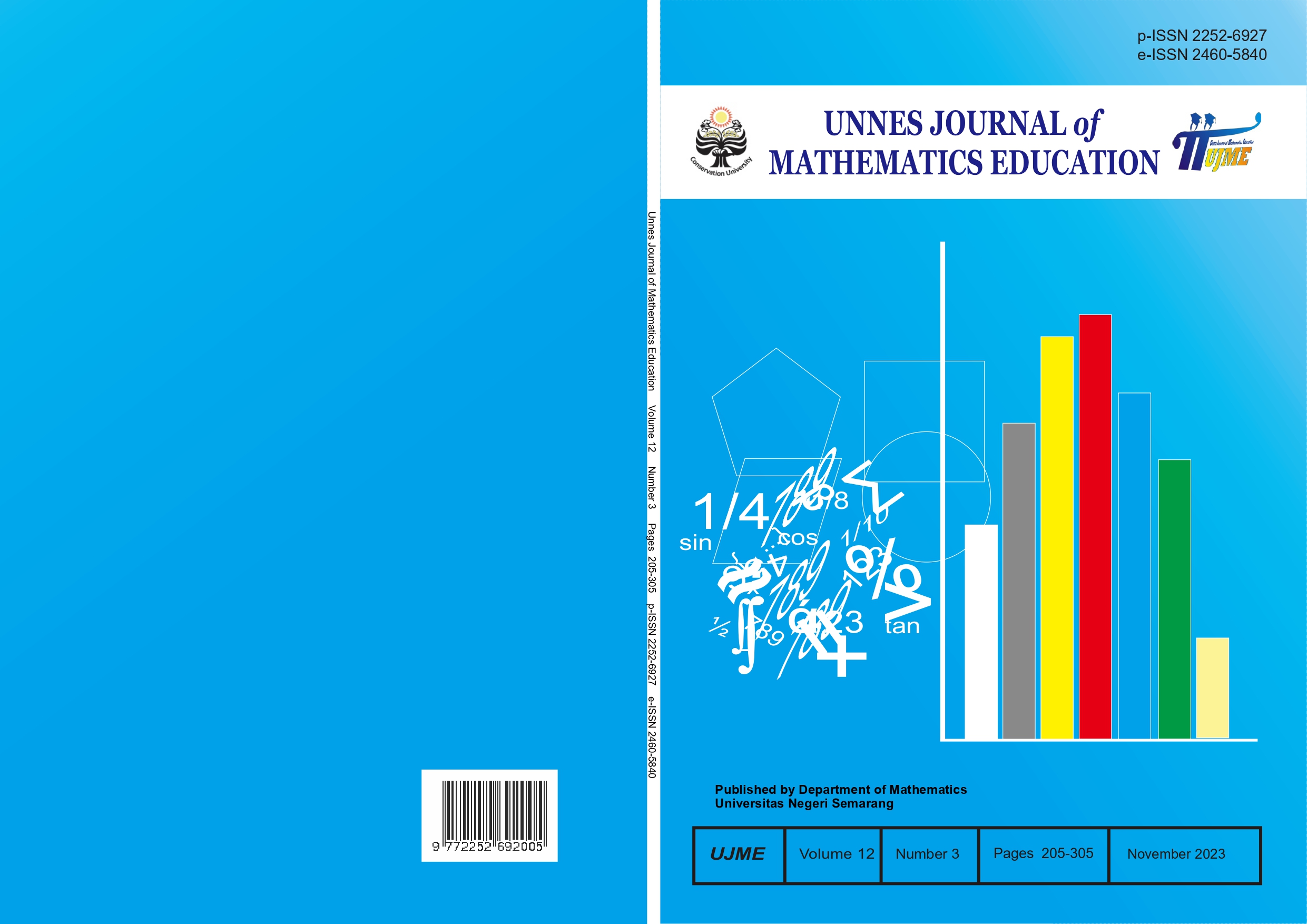How does student learn mathematics through traditional food? (a hypothetical learning trajectory)
##plugins.themes.academic_pro.article.main##
Abstract
This study aimed to design a hypothetical learning trajectory for a two-dimensional figure area (quadrilateral and triangle) using the geometric shape of traditional food, tempe mendoan as a learning context. This research was qualitative research with data collection methods using literature studies, interviews, and documentation. The subjects in this study were seventh-grade junior high school students in SMP IT Nurul Fikri Bogor. The results of this study are in the form of a hypothetical learning trajectory design in learning the two-dimensional figure area through exploration of Banyumas food tempe mendoan, students measure each side of the rectangle from the shape of tempe mendoan, students divide the rectangle into square units as many as the results of each measurement side, students counts the number of unit squares that cover the rectangular area, the student finds the formula for the area of a square and a rectangle. Next, students divide one rectangle into two right triangles of equal size, students find the formula for the area of a triangle. Students attach the triangles to the provided two-dimensional figure shapes, students record the number of right triangles needed to cover each shape and find these relationships so that students can find area formulas for other shapes such as parallelograms, trapezoids, and rhombuses.
##plugins.themes.academic_pro.article.details##
References
Confrey, J., Gianopulos, G., McGowan, W., Shah, M., & Belcher, M. (2017). Scaffolding learner-centered curricular coherence using learning maps and diagnostic assessments designed around mathematics learning trajectories. ZDM - Mathematics Education, 49(5), 717–734. https://doi.org/10.1007/s11858-017-0869-1
Empson, S. B. (2011). On the idea of Learning Trajectories : Promises and Pitfalls Let us know how access to this document benefits you . 8(3).
Freudenthal, H. (2006). Revisiting mathematics education: China lectures. Springer Science & Business Media., 9.
Gravemeijer, K. P. . (1994). Developing Realistic Mathematics Education. Utrecht: CD-b Press.
Gravemeijer, K. P. . (2004). Creating opportunities for students to reinvent mathematics. Regular Lecture at the 10th International Congress on Mathematical Education (ICME 10). http://eprints.uanl.mx/5481/1/1020149995.PDF
Gravemeijer, K. P. . (2010). Realistic mathematics education theory as a guideline for problem-centered, interactive mathematics education. A Decade of PMRI in Indonesia, 41–50.
Hasibuan, A. M., Saragih, S., & Amry, Z. (2018). Development of Learning Materials Based on Realistic Mathematics Education to Improve Problem Solving Ability and Student Learning Independence. International Electronic Journal of Mathematics Education, 14(1), 243–252. https://doi.org/10.29333/iejme/4000
Ivars, P., Fernández, C., Llinares, S., & Choy, B. H. (2018). Enhancing noticing: Using a hypothetical learning trajectory to improve pre-service primary teachers’ professional discourse. Eurasia Journal of Mathematics, Science and Technology Education, 14(11). https://doi.org/10.29333/ejmste/93421
Julie, C., & Gierdien, F. (2020). Reflections on Realistic Mathematics Education from a South African Perspective. https://doi.org/10.1007/978-3-030-20223-1_5
Laurens, T., Batlolona, F. A., Batlolona, J. R., & Leasa, M. (2018). How does realistic mathematics education (RME) improve students’ mathematics cognitive achievement? Eurasia Journal of Mathematics, Science and Technology Education, 14(2), 569–578. https://doi.org/10.12973/ejmste/76959
Minardi, Samidi, & Rahmah, Y. A. (2021). Menelusuri Jejak Kuliner Tembayat dalam Serat Centhini. Manuskripta, 11(1), 105–126.
Ndiung, S., Dantes, N., Ardana, I. M., & Marhaeni, A. A. I. N. (2019). Treffinger creative learning model with RME principles on creative thinking skill by considering numerical ability. International Journal of Instruction, 12(3), 731–744. https://doi.org/10.29333/iji.2019.12344a
Pambudi, W. A. S., Zaeuri, & Kharisudin, I. (2021). KEMAMPUAN PENALARAN DAN REPRESENTASI MATEMATIS SISWA DENGAN MODEL PEMBELAJARAN MIC BERBASIS ETNOMATEMATIKA. Pedagogi: Jurnal Penelitian Pendidikan, 8(2), 87–100. https://doi.org/10.25134/pedagogi.v8i2.4968
Rezky, R., & Wijaya, A. (2018). Designing hypothetical learning trajectory based on van hiele theory: A case of geometry. Journal of Physics: Conference Series, 1097(1). https://doi.org/10.1088/1742-6596/1097/1/012129
Saleh, M., Prahmana, R. C. I., Isa, M., & Murni. (2018). Improving the reasoning ability of elementary school student through the Indonesian realistic mathematics education. Journal on Mathematics Education, 9(1), 41–53. https://doi.org/10.22342/jme.9.1.5049.41-54
Simon, L. (2009). Underground, upperground et middle-ground : les collectifs créatifs et la capacité créative de la ville. Management International, 13, 37–51. https://doi.org/10.7202/037503ar
Ulfa, C., & Wijaya, A. (2019). Expanding hypothetical learning trajectory in mathematics instructional. Journal of Physics: Conference Series, 1320(1). https://doi.org/10.1088/1742-6596/1320/1/012091
Van Den Heuvel-Panhuizen, M. (2003). the Didactical Use of Models in Realistic. Educational Studies in Mathematics, 54, 9–35.
Warsito, W., Nuraini, Y., & Sukirwan, S. (2019). Desain Pembelajaran Pecahan melalui Pendekatan Realistik di Kelas V. Mosharafa: Jurnal Pendidikan Matematika, 8(1), 25–36. https://doi.org/10.31980/mosharafa.v8i1.381
Wijaya, A., Elmaini, & Doorman, M. (2021). A learning trajectory for probability: A case of game-based learning. Journal on Mathematics Education, 12(1), 1–16. https://doi.org/10.22342/JME.12.1.12836.1-16
